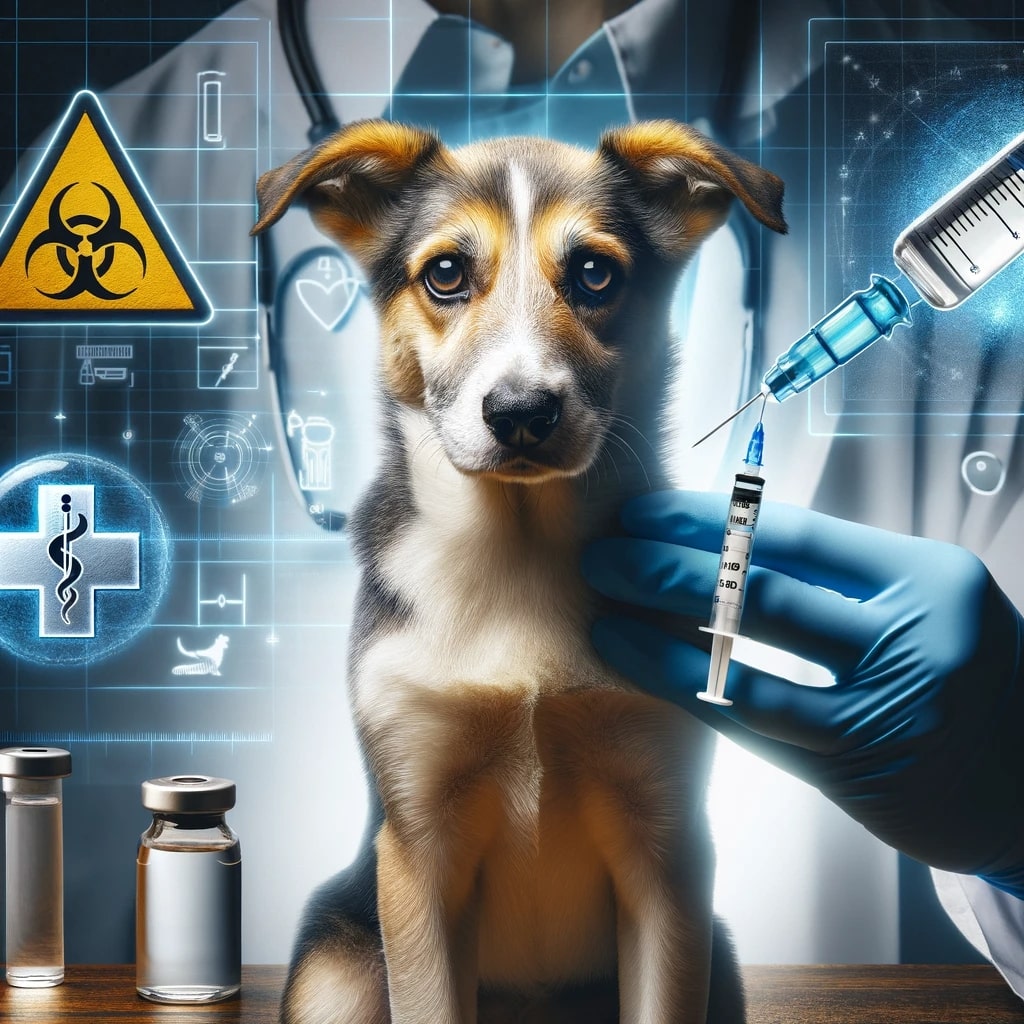Blastomycosis is a significant health concern for dog owners, primarily due to its severe and sometimes elusive symptoms. This guide aims to provide comprehensive information about this fungal infection, addressing the most common questions and concerns that dog owners have.
What is Blastomycosis and How Do Dogs Contract It?
Blastomycosis is a fungal infection caused by the organism Blastomyces dermatitidis. This fungus thrives in moist soil, decaying wood, and other organic materials, particularly in areas near water bodies like lakes and rivers. Dogs contract blastomycosis primarily through inhalation of the fungal spores present in these environments.
- Fungal Habitat: Blastomyces dermatitidis is found in specific geographic regions, particularly in North America, along river valleys and lakes. Understanding these habitats helps in assessing the risk for your dog.
- Inhalation of Spores: Dogs are often infected when they disturb soil containing the spores, such as during digging or sniffing around in endemic areas.
- High-Risk Activities: Activities like hunting, hiking, or even playing in environments conducive to the fungus can increase the risk of contracting blastomycosis.
- No Direct Contagion: It’s important to note that blastomycosis is not typically transmitted from dog to dog or from dogs to humans. The risk comes from the environment.
- Symptom Onset: After inhalation, the spores transform into yeast and start infecting the lungs, potentially spreading to other parts of the body.
- Incubation Period: The incubation period varies and symptoms can appear weeks or even months after exposure.
- Immune Response: The severity of the disease often depends on the dog’s immune system response. Weaker immune systems may lead to more severe cases.
- Environmental Precautions: Awareness of the environment and avoiding high-risk areas can be key in prevention.
- Seasonal Variations: There might be seasonal patterns in the prevalence of blastomycosis, with cases often increasing in certain months due to environmental conditions.
- Breed Susceptibility: While all breeds can be affected, certain breeds like hunting dogs are at higher risk due to their increased exposure to the fungus’ natural habitat.
What Are the Symptoms of Blastomycosis in Dogs?
Recognizing the symptoms of blastomycosis is crucial for timely diagnosis and treatment. The symptoms can vary widely, making it a challenging disease to diagnose.
- Respiratory Symptoms: The most common initial symptoms are related to the respiratory system, such as coughing, wheezing, or difficulty breathing.
- Eye Infections: Blastomycosis can cause eye problems, including inflammation, discharge, and even vision loss.
- Skin Lesions: The fungus can manifest as skin lesions that often appear as small, raised bumps with or without discharge.
- Systemic Signs: Dogs might exhibit systemic signs like fever, weight loss, and lethargy.
- Lameness: In cases where the infection spreads to bones or joints, it can cause lameness or pain in the limbs.
- Appetite Loss: Affected dogs may show a reduced appetite due to the discomfort and systemic impact of the infection.
- Lymphadenopathy: Swelling of the lymph nodes is another possible symptom of blastomycosis.
- Nervous System Involvement: In advanced cases, the fungus can affect the nervous system, leading to seizures or other neurological symptoms.
- Variable Presentation: Symptoms can vary greatly from one dog to another, making it hard to diagnose based solely on clinical signs.
- Severity and Progression: The severity and speed of symptom progression can vary, with some dogs becoming severely ill very quickly.
How is Blastomycosis Diagnosed in Dogs?
Diagnosing blastomycosis in dogs involves a combination of clinical examination, history, and specific diagnostic tests. Early and accurate diagnosis is crucial for effective treatment.
- Veterinary Examination: A thorough veterinary examination is the first step, where the vet assesses the dog’s symptoms and medical history.
- Diagnostic Tests: Common diagnostic tests include chest X-rays, blood tests, urine tests, and tissue biopsies.
- Chest X-rays: These are used to detect lung involvement, which is common in blastomycosis.
- Cytology and Biopsy: Examination of cells from affected tissues can reveal the presence of the fungus.
- Urine Blastomyces Antigen Test: This is a relatively new and highly sensitive test that detects fungal antigens in the urine.
- Blood Tests: While not specific for blastomycosis, blood tests can help rule out other conditions and assess overall health.
- Fungal Cultures: Growing the fungus from a sample can confirm the diagnosis but is less commonly used due to the time it takes.
- Differential Diagnosis: It’s essential to differentiate blastomycosis from other diseases with similar symptoms, like cancer or bacterial infections.
- Environmental Factors: Consideration of the dog’s exposure to endemic areas can support the diagnosis.
- Repeated Testing: In some cases, repeated or multiple tests may be necessary to confirm the diagnosis.
What Treatment Options are Available for Blastomycosis in Dogs?
Treatment of blastomycosis in dogs is a long-term commitment and involves specific antifungal medications.
- Antifungal Medications: The primary treatment is antifungal drugs, with Itraconazole being the most commonly used.
- Treatment Duration: Treatment usually lasts for several months and should not be discontinued early to prevent relapse.
- Monitoring Response to Treatment: Regular veterinary check-ups are necessary to monitor the dog’s response to treatment and adjust medications as needed.
- Managing Side Effects: Some antifungal drugs can have side effects, and dogs on these medications need monitoring for liver function and other potential issues.
- Supportive Care: Supportive care, including proper nutrition and hydration, is crucial for recovery.
- Severe Cases: In severe cases, additional treatments like oxygen therapy or intravenous fluids may be necessary.
- Environmental Management: While treatment is ongoing, minimizing the dog’s exposure to high-risk areas is advisable.
- Cost Consideration: Treatment for blastomycosis can be costly, and pet owners should be prepared for this aspect.
- Prognosis with Treatment: With timely and appropriate treatment, many dogs recover fully, but the prognosis varies depending on the severity of the disease.
- Importance of Adherence: Strict adherence to the treatment plan is essential for successful recovery.
Can Blastomycosis be Prevented in Dogs?
While it is challenging to completely prevent blastomycosis due to its environmental nature, certain precautions can reduce a dog’s risk of exposure.
- Awareness of Endemic Areas: Knowing which areas are high-risk for blastomycosis can help in taking precautionary measures.
- Avoiding High-Risk Activities: Limiting activities in wooded, wet areas or places known to harbor the fungus can reduce exposure.
- Environmental Control: While difficult, controlling the environment, such as avoiding areas with a lot of decaying wood or damp soil, can be helpful.
- Regular Health Checks: Regular veterinary check-ups can help in early detection of not only blastomycosis but other diseases as well.
- Monitoring Dogs Post-Exposure: If a dog has been in a high-risk area, close monitoring for symptoms is advised.
- Educating Dog Owners: Knowledge about blastomycosis, its symptoms, and risk factors is crucial for prevention.
- Prompt Medical Attention: Seeking immediate veterinary care when symptoms are noticed can prevent complications.
- Use of Protective Gear: In some cases, using protective gear like booties or coats might help reduce exposure during outdoor activities.
- Hygiene Practices: Regular grooming and cleaning of your dog after outdoor activities can help in removing potential spores.
- Community Awareness: Community awareness in endemic areas can help in broader prevention and early detection efforts.
What is the Prognosis for Dogs with Blastomycosis?
The prognosis for dogs with blastomycosis varies depending on several factors including the severity of the disease, how early it is diagnosed, and how well the dog responds to treatment.
- Early Detection and Treatment: Dogs diagnosed and treated early generally have a better prognosis.
- Severity of the Disease: Dogs with severe forms of the disease, especially with central nervous system involvement, may have a poorer prognosis.
- Response to Treatment: Dogs that respond well to antifungal therapy often recover completely.
- Overall Health Status: The dog’s general health and immune status play a significant role in recovery.
- Complications: The development of complications such as secondary bacterial infections can affect the prognosis.
- Follow-up Care: Regular follow-up with a veterinarian is crucial for monitoring and adjusting treatment.
- Treatment Duration: Longer treatment duration is often required, and premature discontinuation of treatment can worsen the prognosis.
- Relapse Possibility: There is a risk of relapse, which requires renewed treatment.
- Supportive Care: Adequate supportive care throughout the treatment period can improve outcomes.
- Pre-existing Conditions: Dogs with pre-existing health conditions may face additional challenges in recovery.
Are Certain Dog Breeds More Susceptible to Blastomycosis?
While blastomycosis can affect any dog breed, certain factors related to breed characteristics and lifestyle may influence susceptibility.
- Geographical Location: Dogs living in or frequently visiting endemic areas are at a higher risk, regardless of breed.
- Outdoor Lifestyle: Breeds that spend more time outdoors, especially in wooded or wet environments, are more susceptible.
- Hunting and Working Breeds: Breeds such as hounds, retrievers, and pointers, often used for hunting or outdoor work, have increased exposure to the fungus.
- Size and Snout Shape: Larger breeds and those with longer snouts may inhale more spores due to deeper digging and sniffing habits.
- Age and Immune Status: While not breed-specific, younger and older dogs, or those with compromised immune systems, may be more susceptible.
- Coat Type: There is no direct evidence linking coat type to susceptibility, but dogs with thicker coats may carry spores in their fur longer.
- Behavioral Factors: Breeds with tendencies to dig and explore dense vegetation may have a higher risk.
- Prevalence Data: Some studies suggest higher incidence rates in certain breeds, but this may reflect geographical and lifestyle factors more than genetic susceptibility.
- Breeding for Resistance: Currently, there is no evidence that selective breeding can produce resistance to blastomycosis.
- Overall Health: A breed’s general health profile can influence its ability to fight off infections, including blastomycosis.
How Can Dog Owners Recognize Early Signs of Blastomycosis?
Early recognition of blastomycosis symptoms can lead to prompt treatment and better outcomes. Dog owners should be aware of the following signs:
- Respiratory Distress: Persistent cough, difficulty breathing, or increased respiratory rate can be early signs.
- Eye Changes: Redness, swelling, or discharge from the eyes should not be ignored.
- Skin Lesions: Unexplained sores or lesions, especially if not healing, can be indicative.
- Behavioral Changes: Lethargy, reduced appetite, or uncharacteristic behavior might signal an underlying issue.
- Fever: While not always present, fever can be an early sign of infection.
- Weight Loss: Unexplained weight loss should always warrant veterinary attention.
- Lameness or Stiffness: This could indicate joint or bone involvement.
- Lymph Node Swelling: Noticeable swelling in the lymph nodes can be a sign of infection.
- Rapid Deterioration: Any rapid decline in health should be treated as an emergency.
- Environmental Exposure: Awareness of recent activities in high-risk areas can help in correlating symptoms.
What are the Long-term Effects of Blastomycosis in Dogs?
Understanding the potential long-term effects of blastomycosis is important for managing a dog’s health post-recovery.
- Respiratory Complications: Some dogs may suffer from chronic respiratory issues after severe lung infections.
- Eye Damage: In cases where the eyes were affected, there can be lasting impairment or vision loss.
- Joint Problems: Dogs with bone or joint involvement may experience ongoing pain or lameness.
- Neurological Sequelae: If the nervous system was affected, there might be lasting neurological symptoms.
- Relapse Risk: There is a potential for relapse, necessitating ongoing vigilance for symptoms.
- Chronic Medication: Some dogs may require long-term antifungal therapy or other medications.
- Immune System Impact: The dog’s immune system might be weakened, increasing susceptibility to other infections.
- Behavioral Changes: Long-term illness can lead to changes in behavior or temperament.
- Physical Scarring: Skin lesions may leave permanent scars or changes in the coat.
- Quality of Life Considerations: Managing long-term effects is key to maintaining a good quality of life post-recovery.
Is There a Vaccine for Blastomycosis in Dogs?
Currently, there is no available vaccine for blastomycosis in dogs. Research in this area is ongoing, but prevention primarily relies on environmental awareness and management.
- Research Challenges: Developing a vaccine for a fungal infection like blastomycosis presents significant scientific challenges.
- Current Prevention Methods: The focus remains on minimizing exposure to environments where the fungus is prevalent.
- Veterinary Developments: Ongoing research in veterinary medicine may eventually lead to a vaccine, but none is available as of now.
- Immune Response Complexity: The complexity of the immune response to fungal infections makes vaccine development difficult.
- Potential Future Breakthroughs: Advances in immunology and fungal biology could pave the way for a vaccine in the future.
- Regular Veterinary Care: In lieu of a vaccine, regular health checks and prompt medical attention for symptoms are crucial.
- Environmental Controls: Understanding and managing environmental risk factors remain key in prevention.
- Community Awareness: Education and awareness in communities can help in early detection and prevention strategies.
- Alternative Treatments: Research into new treatments and management strategies continues to be important.
- Monitoring Disease Trends: Keeping abreast of trends in blastomycosis can inform future prevention and treatment strategies.
How Does Blastomycosis in Dogs Affect Human Health?
While blastomycosis is primarily a concern for dogs, understanding its potential impact on human health is important for pet owners.
- Zoonotic Potential: Although rare, there is a potential for blastomycosis to infect humans, particularly those with compromised immune systems.
- Environmental Risk: Humans contract blastomycosis the same way dogs do – from the environment, not directly from an infected dog.
- Precautionary Measures: Handling infected dogs and their bodily fluids with care is advisable, especially for immunocompromised individuals.
- Awareness of Symptoms: Humans should be aware of blastomycosis symptoms, especially if living in or visiting endemic areas.
- Shared Environments: If a dog is diagnosed with blastomycosis, it indicates the presence of the fungus in the shared environment.
- Veterinary and Medical Collaboration: Collaboration between veterinarians and medical doctors can be beneficial in areas where blastomycosis is common.
- Public Health Concerns: Understanding the disease dynamics in dogs can help in addressing public health concerns.
- Research Implications: Studies on blastomycosis in dogs can provide insights into human susceptibility and treatment.
- Community Health Strategies: In endemic areas, community health strategies should consider both human and animal health.
- Educational Outreach: Educating pet owners about zoonotic diseases like blastomycosis is crucial for overall health and safety.
What Is the Cost of Treating Blastomycosis in Dogs?
The cost of treating blastomycosis can vary widely depending on the severity of the disease, the duration of treatment, and regional veterinary costs.
- Antifungal Medication Costs: The primary expense is usually the antifungal medication, which can be costly and is often required for several months.
- Veterinary Visits: Regular check-ups, including follow-up tests to monitor the dog’s response to treatment, add to the cost.
- Diagnostic Testing: Initial diagnostic testing such as blood tests, X-rays, and urine tests can be expensive.
- Hospitalization Expenses: In severe cases, hospitalization for intensive care or oxygen therapy may be necessary, which significantly increases costs.
- Treatment Duration: The long duration of treatment (often several months) contributes to the overall expense.
- Additional Medications: Treatment of complications or secondary infections requires additional medication, adding to the cost.
- Supportive Care: Costs for supportive care, including nutritional supplements or special diets, should also be considered.
- Geographic Variations: Costs can vary significantly depending on the geographical location and availability of veterinary services.
- Insurance Considerations: Pet health insurance might cover some of the costs, but coverage varies greatly among policies.
- Financial Planning: Owners should be prepared for the financial commitment of treating blastomycosis and discuss all options with their veterinarian.
How to Care for a Dog Recovering from Blastomycosis?
Caring for a dog recovering from blastomycosis involves a combination of medical treatment, home care, and regular monitoring.
- Adherence to Medication: Strict adherence to the prescribed antifungal medication is crucial for recovery.
- Nutritional Support: Providing a balanced diet to support the dog’s immune system and overall health is important.
- Comfortable Environment: Ensuring the dog has a comfortable, quiet place to rest aids in recovery.
- Monitoring for Side Effects: Watching for any side effects of the medication and reporting them to the vet is necessary.
- Regular Veterinary Check-ups: Frequent check-ups allow for monitoring of the dog’s progress and any necessary adjustments in treatment.
- Limiting Exposure: Avoiding areas where the dog might be re-exposed to the fungus is crucial during recovery.
- Exercise and Activity: Managing exercise and activity levels based on the dog’s health and energy levels.
- Emotional Support: Providing emotional support and companionship aids in the recovery process.
- Hygiene: Maintaining good hygiene, especially if the dog had skin lesions, to prevent secondary infections.
- Owner Education: Educating the owner about the disease, its management, and the importance of follow-up care is key.
Summary Table of Blastomycosis in Dogs
| Aspect | Details |
| What is Blastomycosis? | A fungal infection caused by Blastomyces dermatitidis, commonly contracted by dogs through inhalation in moist, wooded areas. |
| Symptoms | Include respiratory distress, eye infections, skin lesions, lameness, fever, weight loss, and lethargy. |
| Diagnosis | Through veterinary examination, chest X-rays, blood tests, urine tests, tissue biopsies, and urine Blastomyces antigen test. |
| Treatment | Primarily antifungal medications (e.g., Itraconazole), lasting several months, with regular monitoring and supportive care. |
| Prevention | Avoidance of high-risk areas, awareness of endemic regions, and regular health checks. |
| Prognosis | Varies based on disease severity and response to treatment; generally favorable with early detection and treatment. |
| Breed Susceptibility | More common in outdoor, hunting, and working breeds but can affect any dog. |
| Cost of Treatment | Can be high due to long-term medication, diagnostic testing, and veterinary care. |
| Post-Recovery Care | Continued medication adherence, nutritional support, and regular veterinary check-ups. |
| Human Health Impact | Rarely transmissible to humans; primarily an environmental hazard. |
| Vaccine Availability | No vaccine currently available for blastomycosis in dogs. |
Frequently Asked Questions About Blastomycosis in Dogs
No, human infection from dogs is extremely rare. The disease is primarily contracted from the environment.
Treatment typically lasts several months, depending on the severity and response to the medication.
No breed is immune to blastomycosis; however, outdoor, hunting, and working breeds are more susceptible due to their increased exposure to high-risk environments.
The survival rate varies. Early detection and treatment generally lead to a better prognosis.
Blastomycosis is not typically transmitted between dogs. It is contracted from the environment.
The first signs include respiratory distress, eye changes, skin lesions, and behavioral changes.
Yes, there is a potential for relapse, necessitating ongoing vigilance for symptoms even after treatment.
Conclusion
Blastomycosis in dogs is a serious fungal infection that requires prompt attention and prolonged treatment. Understanding the disease, recognizing its symptoms early, and adhering to treatment and prevention strategies are crucial for managing this condition. With careful management and regular veterinary care, dogs can recover and maintain a good quality of life.



